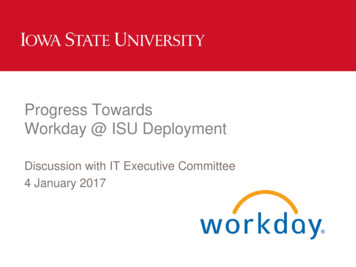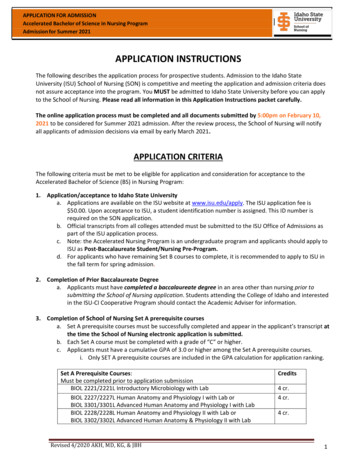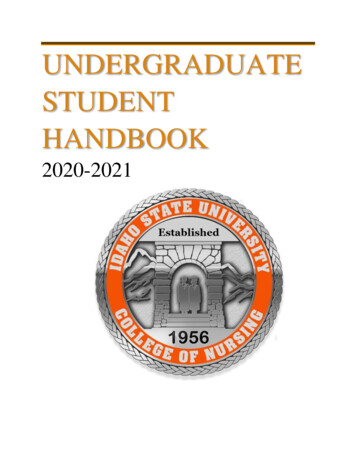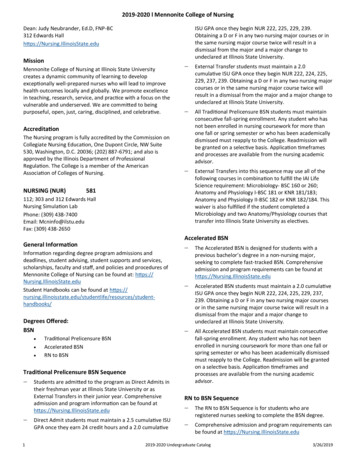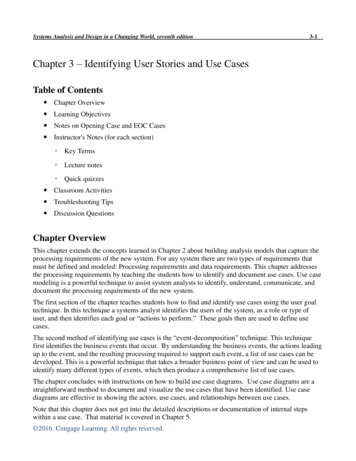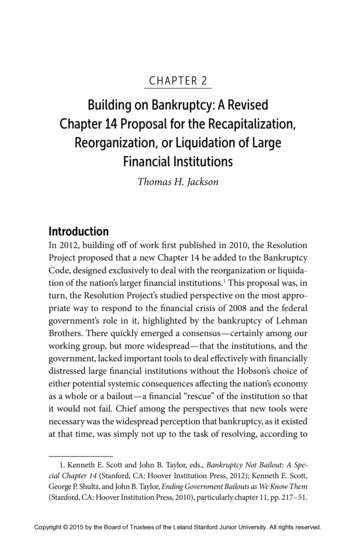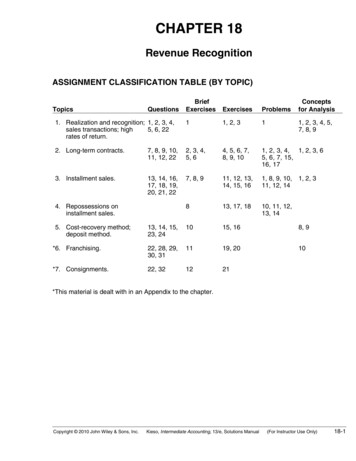
Transcription
CHAPTER 18Revenue RecognitionASSIGNMENT CLASSIFICATION TABLE (BY TOPIC)BriefExercisesExercisesProblems*1. Realization and recognition; 1, 2, 3, 4,sales transactions; high5, 6, 22rates of return.11, 2, 31*2. Long-term contracts.7, 8, 9, 10,11, 12, 222, 3, 4,5, 64, 5, 6, 7,8, 9, 101, 2, 3, 4, 1, 2, 3, 65, 6, 7, 15,16, 17*3. Installment sales.13, 14, 16,17, 18, 19,20, 21, 227, 8, 911, 12, 13,14, 15, 161, 8, 9, 10,11, 12, 14813, 17, 1810, 11, 12,13, 14TopicsQuestions*4. Repossessions oninstallment sales.Conceptsfor Analysis1, 2, 3, 4, 5,7, 8, 91, 2, 3*5. Cost-recovery method;deposit method.13, 14, 15,23, 241015, 168, 9*6. Franchising.22, 28, 29,30, 311119, 2010*7. Consignments.22, 321221*This material is dealt with in an Appendix to the chapter.Copyright 2010 John Wiley & Sons, Inc.Kieso, Intermediate Accounting, 13/e, Solutions Manual(For Instructor Use Only)18-1
ASSIGNMENT CLASSIFICATION TABLE (BY LEARNING OBJECTIVE)Learning ObjectivesBriefExercisesExercisesProblems1.Apply the revenue recognition principle.11, 2, 32.Describe accounting issues for revenuerecognition at point of sale.11, 2, 313.Apply the percentage-of-completion methodfor long-term contracts.2, 34, 5, 6, 7, 8, 91, 2, 3, 4, 5,6, 7, 16, 174.Apply the completed-contract methodfor long-term contracts.4, 54, 8, 9, 101, 2, 3, 5, 6, 7,15, 16, 175.Identify the proper accounting for losseson long-term contracts.6105, 6, 7, 156.Describe the installment-sales methodof accounting.7, 8, 911, 12, 13, 14,15, 16, 17, 181, 8, 9, 10, 11,12, 13, 147.Explain the cost-recovery methodof accounting.1015, 16Explain revenue recognition for franchisesand consignment sales.11, 1219, 20, 21*8.18-2Copyright 2010 John Wiley & Sons, Inc.Kieso, Intermediate Accounting, 13/e, Solutions Manual(For Instructor Use Only)
ASSIGNMENT CHARACTERISTICS P18-14P18-15Level ofTimeDifficulty (minutes)DescriptionRevenue recognition on book sales with high returns.Sales recorded both gross and net.Revenue recognition on marina sales with discounts.Recognition of profit on long-term contracts.Analysis of percentage-of-completion financial statements.Gross profit on uncompleted contract.Recognition of profit, percentage-of-completion.Recognition of revenue on long-term contract and entries.Recognition of profit and balance sheet amounts for longterm contracts.Long-term contract reporting.Installment-sales method calculations, entries.Analysis of installment-sales accounts.Gross profit calculations and repossessed merchandise.Interest revenue from installment sale.Installment-sales method and cost-recovery method.Installment-sales method and cost-recovery method.Installment-sales—default and repossession.Installment-sales—default and repossession.Franchise entries.Franchise fee, initial down payment.Consignment 20Comprehensive three-part revenue recognition.Recognition of profit on long-term contract.Recognition of profit and entries on long-term contract.Recognition of profit and balance sheet presentation,percentage-of-completion.Completed contract and percentage-of-completionwith interim loss.Long-term contract with interim loss.Long-term contract with an overall loss.Installment-sales computations and entries.Installment-sales income statements.Installment-sales computations and entries.Installment-sales entries.Installment-sales computations and entries—periodicinventory.Installment repossession entries.Installment-sales computations and schedules.Completed-contract rate20–2550–6020–30Copyright 2010 John Wiley & Sons, Inc.Kieso, Intermediate Accounting, 13/e, Solutions Manual(For Instructor Use Only)18-3
ASSIGNMENT CHARACTERISTICS TABLE (Continued)DescriptionLevel ofTimeDifficulty (minutes)P18-16P18-17Revenue recognition methods—comparison.Comprehensive problem—long-term Revenue recognition—alternative methods.Recognition of revenue—theory.Recognition of revenue—theory.Recognition of revenue—bonus dollars.Recognition of revenue from subscriptions.Long-term contract—percentage-of-completion.Revenue recognition—real estate development.Revenue recognition, ethicsRevenue recognition—membership fees, ethicsFranchise 35–45Item18-4Copyright 2010 John Wiley & Sons, Inc.Kieso, Intermediate Accounting, 13/e, Solutions Manual(For Instructor Use Only)
SOLUTIONS TO CODIFICATION EXERCISESCE18-1Master Glossary(a)Under the cost-recovery method, no profit is recognized until cash payments by the buyer,including principal and interest on debt due to the seller and on existing debt assumed by thebuyer, exceed the seller’s cost of the property sold.(b)A method of recognizing profit for time-sharing transactions under which the amount of revenuerecognized (based on the sales value) at the time a sale is recognized is measured by the relationship of costs already incurred to the total of costs already incurred and future costs expectedto be incurred.(c)Under the deposit method, the seller does not recognize any profit, does not record notesreceivable, continues to report in its financial statements the property and the related existingdebt even if it has been assumed by the buyer, and discloses that those items are subject to asales contract.(d)The installment-sales method apportions each cash receipt and principal payment by the buyeron debt assumed between cost recovered and profit. The apportionment is in the same ratio astotal cost and total profit bear to the sales value.CE18-2According to FASB ASC 605-10-25-3 (Revenue Recognition—Recognition):Revenue should ordinarily be accounted for at the time a transaction is completed, with appropriate provision for uncollectible accounts. Revenue and gains generally are not recognized until being realized orrealizable and until earned. Accordingly, unless the circumstances are such that the collection of the saleprice is not reasonably assured, the installment-sales method of recognizing revenue is not acceptable.CE18-3According to FASB ASC 910-605-50-2 (Contractors—Revenue Recognition—Disclosure):If the completed-contract method is used, the reason for selecting that method shall be indicated, forexample, either of the following:(a)Numerous short-term contracts for which financial position and results of operations reported onthe completed-contract basis would not vary materially from those resulting from use of thepercentage-of-completion method.(b)Inherent hazards or undependable estimates that cause forecasts to be doubtful.Copyright 2010 John Wiley & Sons, Inc.Kieso, Intermediate Accounting, 13/e, Solutions Manual(For Instructor Use Only)18-5
CE18-4According to FASB ASC 605-10-25-4 (Revenue Recognition—Recognition):There may be exceptional cases where receivables are collectible over an extended period of time and,because of the terms of the transactions or other conditions, there is no reasonable basis for estimatingthe degree of collectibility. When such circumstances exist, and as long as they exist, either the installmentsales method or the cost recovery method of accounting may be used. As defined in paragraph 360-2055-7 through 55-9, the installment-sales method apportions collections received between cost recovered and profit. The apportionment is in the same ratio as total cost and total profit bear to the sales value.Under the cost recovery method, equal amounts of revenue and expense are recognized as collectionsare made until all costs have been recovered, postponing any recognition of profit until that time.18-6Copyright 2010 John Wiley & Sons, Inc.Kieso, Intermediate Accounting, 13/e, Solutions Manual(For Instructor Use Only)
ANSWERS TO QUESTIONS1.A series of highly publicized cases of companies recognizing revenue prematurely has causedthe SEC to increase its enforcement actions in this area. In some of these cases, significantadjustments to previously issued financial statements were made. Some of these cases involvedcontingent sales where side agreements were in place or high rates of return occurred. Inaddition, in some cases, unfinished product was shipped to customers and counted as revenuesor unauthorized product was shipped to customers and counted as revenues.2.Revenue is conventionally recognized at the date of sale. For revenue to be recognized at thedate of sale, (1) the amount of the revenue should be reasonably measurable—that is, thecollectibility of the sales price is reasonably assured or the amount uncollectible can beestimated reasonably (realized or realizable)—and (2) the earnings process is complete orvirtually complete—that is, the seller is not obligated to perform significant activities after the saleto earn the revenue.3.Revenues are recognized generally as follows:(a) Revenue from selling products—date of delivery to customers.(b) Revenue from services rendered—when the services have been performed and are billable.(c) Revenue from permitting others to use enterprise assets—as time passes or as the assetsare used.(d) Revenue from disposing of assets other than products—at the date of sale.4.Types of sales transactions: (1) Cash sale. (2) Credit sale. (3) C.O.D. sale. (4) Will-call or layawaysale. (5) Sale in advance of delivery (long-term construction). (6) Branch sale. (7) Intercompanysale. (8) Franchise sale. (9) Installment sale.The student should identify for each type of sale a form of business which typically engages inthat type of sale. Many of these sales transactions are not mentioned in this chapter, so thestudent will probably not identify all these transactions.5.The three alternatives available to a seller that is exposed to risks of ownership due to a return ofthe product are:(1) Not recording the sale until all return privileges have expired.(2) Recording the sale, but reducing sales by an estimate of future returns.(3) Recording the sale and accounting for the returns as they occur in the future.6.FASB Statement No. 48 requires that such sales transactions not be recognized as currentrevenue unless all of the following six conditions are met:(1) The seller’s price to the buyer is substantially fixed or determinable at the date of sale.(2) The buyer has paid the seller, or the buyer is obligated to pay the seller and the obligation isnot contingent on resale of the product.(3) The buyer’s obligation to the seller would not be changed in the event of theft, or physicaldestruction, or damage of the product.(4) The buyer acquiring the product has economic substance apart from that provided by theseller.(5) The seller does not have a significant obligation for future performance to directly bringabout resale of the product by the buyer.(6) The amount of future returns can be reasonably estimated.7.The two basic methods of accounting for long-term construction contracts are: (1) the percentageof-completion method and (2) the completed-contract method.Copyright 2010 John Wiley & Sons, Inc.Kieso, Intermediate Accounting, 13/e, Solutions Manual(For Instructor Use Only)18-7
Questions Chapter 18 (Continued)The percentage-of-completion method is preferable when estimates of costs to complete andextent of progress toward completion of long-term contracts are reasonably dependable. Thepercentage-of-completion method should be used in circumstances when reasonably dependableestimates can be made and:(1) The contract clearly specifies the enforceable rights regarding goods or services to beprovided and received by the parties, the consideration to be exchanged, and the mannerand terms of settlement.(2) The buyer can be expected to satisfy all obligations under the contract.(3) The contractor can be expected to perform the contractual obligation.The completed-contract method is preferable when the lack of dependable estimates or inherenthazards cause forecasts to be doubtful.8.Costs IncurredTotal Estimated Cost 9 million 50 millionX Total Revenue Revenue RecognizedX 60,000,000 10,800,000Revenue Recognized – Actual Cost Incurred Gross Profit Recognized 10,800,000 – 9,000,000 1,800,0009.Under the percentage-of-completion method, income is reported to reflect more accurately theproduction effort. Income is recognized periodically on the basis of the percentage of the jobcompleted rather than only when the entire job is completed. The principal disadvantage of thecompleted-contract method is that it may lead to distortion of earnings because no attempt ismade to reflect current performance when the period of the contract extends into more than oneaccounting period.10.The methods used to determine the extent of progress toward completion are the cost-to-costmethod and units-of-delivery method. Costs incurred and labor hours worked are examples ofinput measures, while tons produced, stories of a building completed, and miles of highwaycompleted are examples of output measures.11.The two types of losses that can become evident in accounting for long-term contracts are:(1) A current period loss involved in a contract that, upon completion, is expected to producea profit.(2) A loss related to an unprofitable contract.The first type of loss is actually an adjustment in the current period of gross profit recognized onthe contract in prior periods. It ar
According to FASB ASC 605-10-25-3 (Revenue Recognition—Recognition): Revenue should ordinarily be accounted for at the time a transaction is completed, with appropriate provi-sion for uncollectible accounts. Revenue and gains generally are not recognized until being realized or realizable and until earned. Accordingly, unless the circumstances are such that the collection of the saleFile Size: 247KBPage Count: 92People also search foraccounting chapter 3 answerschapter 5 accounting answerschapter 6 accounting answersaccounting chapter 6 comprehensive probl accounting chapter 6 quiz answersfinancial accounting chapter 6 answers
